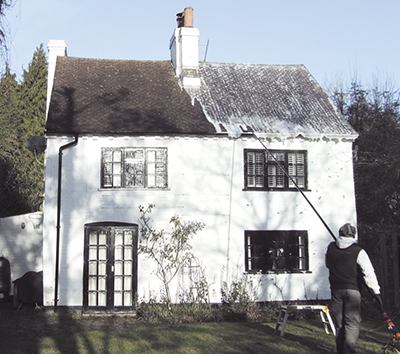Old timber and old render
 With the British weather against us, protecting timber surfaces outside can be challenging. The accepted wisdom is to use a more or less transparent oil or resin, but does this work well? Not really, as the oil becomes the problem - overcoating increases the opacity of the stain to a point where the veins are no longer seen. There can be flaking too, followed by a weary sanding job!
With the British weather against us, protecting timber surfaces outside can be challenging. The accepted wisdom is to use a more or less transparent oil or resin, but does this work well? Not really, as the oil becomes the problem - overcoating increases the opacity of the stain to a point where the veins are no longer seen. There can be flaking too, followed by a weary sanding job!
There is an alternative which keeps the agents responsible for the damage away - and this is achieved by using an appropriate biocidal detergent.
Wood rot is caused by a fungi and the biocide should be used to saturation point, so as to kill the nescent fungal hypae before damage is done. The black dots are a tell tale sign - if they are kept away, the wood will not rot. Treated this way, natural timber will change appearance under the influence of the weather.
Wood is made of three main constituents. The cellulose represents approximately half the mass and consists of short, sharp needles woven into long strands. The needles have a binder which forms a sophisticated composite material with good mechanical properties. The lignin is a hard polymer resin accounting for a quarter of the wood mass. The remaining mass is a mix of hemicellulose, minerals and an array of polymers providing natural defences, colour and smell.
When outdoors, sawn timber will first lose the water soluble elements which are exposed to the rain. The other polymers, including the lignin, will become water soluble under the action of the light. This phase is observed by a change of colour, known as photo oxidation.
The combined effect of light and rain will gradually expose the silver grey cellulose. As the saw cuts through the needles' longitudinal arrangements at every wave in the grain, the unbound needle ends tend to rise under surface desiccation, feeling sharp and abrasive to the finger. Such a textured surface retains moistures and becomes a natural host for an array of biological species such as bacteria, fungi and algae. They feed on the substrate and release metabolites, preparing it for further and faster feeding.
The bio-colonisation of bare cellulose is easy to control. A product such as AlgoClear ticks all the boxes with regard to environmental footprint, safety and ease of use. It is applied with ordinary garden implements.
The periodicity of application will vary from site to site but twice a year is a good starting point. If a shady corner requires a more frequent application, just reach out for the watering can for some localised treatment. If this is done in time, no brushing will be necessary.
Does it treat other surfaces? Yes, very much so, as the biocidal detergent acts on the biofilm, regardless of the nature of the substrate - and the biocidal treatments are particularly effective on porous surfaces.
Thames Valley Specialist Products Ltd market a building cleaning process known as Algoclear Softwash. The company operates in the UK and Ireland.
For further information visit www.renderclean.biz and www.softwashireland.ie.













